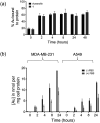Antiproliferative effects, mechanism of action and tumor reduction studies in a lung cancer xenograft mouse model of an organometallic gold(i) alkynyl complex
- PMID: 40201730
- PMCID: PMC11975047
- DOI: 10.1039/d4md00964a
Antiproliferative effects, mechanism of action and tumor reduction studies in a lung cancer xenograft mouse model of an organometallic gold(i) alkynyl complex
Abstract
Organometallic complexes offer a wide range of properties like structural variety, reaction kinetics, tunable lipophilicity and alternate mechanisms of activation under physiological conditions compared to platinum chemotherapeutics and are thus being explored for their potential anticancer applications. In this regard, gold(i) organometallics hold a pivotal position for their ability to act on biological targets different from DNA (which is the primary target of platinum therapeutics), such as thioredoxin reductase. Here, we report on the stability, in vitro antiproliferative effects, protein binding, cellular uptake, mechanism of action, effects on mitochondrial respiration of cancer cells as well as in vivo tolerance, toxicity and tumor reduction in an A549 lung cancer xenograft mouse model of an organometallic gold(i) complex (1) bearing 4-ethynylanisole and triethylphosphane as ligands. The complex, which was stable in DMSO and reactive towards N-acetylcysteine, triggered strong antiproliferative effects in various cancer cell lines and had a protein binding of approximately 65% that reduced its generally efficient uptake into tumor cells. Antimetastatic properties were indicated for 1 in a scratch assay and strong inhibition of thioredoxin reductase (TrxR) was confirmed for the purified enzyme as well as in A549 lung cancer cells, which strongly overexpress TrxR. Real time monitoring of the oxygen consumption rate in multiple cancer cell lines, using the Seahorse Mito stress assay, demonstrated that mitochondrial respiration was severely disrupted, showing a significantly low oxygen consumption rate. Other respiratory parameters, such as proton efflux, spare respiratory capacity and maximal respiration, were also attenuated upon treatment with 1. The complex was well tolerated in vivo in mice at a dose of 10 mg kg-1 and showed tumor reduction compared to the control group of animals in a lung cancer xenograft model of nude mice. In summary, complex 1 represents a novel organometallic anticancer drug candidate with a mechanism related to TrxR inhibition and mitochondrial respiration inhibition, showing efficient in vivo antitumor efficacy.
This journal is © The Royal Society of Chemistry.
Conflict of interest statement
There are no conflicts of interest to declare.
Figures








Similar articles
-
Molecular feature-based classification of retroperitoneal liposarcoma: a prospective cohort study.Elife. 2025 May 23;14:RP100887. doi: 10.7554/eLife.100887. Elife. 2025. PMID: 40407808 Free PMC article.
-
Surveillance for Violent Deaths - National Violent Death Reporting System, 50 States, the District of Columbia, and Puerto Rico, 2022.MMWR Surveill Summ. 2025 Jun 12;74(5):1-42. doi: 10.15585/mmwr.ss7405a1. MMWR Surveill Summ. 2025. PMID: 40493548 Free PMC article.
-
Introduction of 1,3-diethyl-4,5-diphenyl-4,5-dihydro-1H-imidazol-2-ylidene as new ligand for the design of antitumor-active (NHC)gold(I) complexes: An approach to reduce ligand scrambling and to increase tumor cell selectivity.Eur J Med Chem. 2025 Jun 30;299:117919. doi: 10.1016/j.ejmech.2025.117919. Online ahead of print. Eur J Med Chem. 2025. PMID: 40815902
-
Assessing the comparative effects of interventions in COPD: a tutorial on network meta-analysis for clinicians.Respir Res. 2024 Dec 21;25(1):438. doi: 10.1186/s12931-024-03056-x. Respir Res. 2024. PMID: 39709425 Free PMC article. Review.
-
Defining disease severity in atopic dermatitis and psoriasis for the application to biomarker research: an interdisciplinary perspective.Br J Dermatol. 2024 Jun 20;191(1):14-23. doi: 10.1093/bjd/ljae080. Br J Dermatol. 2024. PMID: 38419411 Free PMC article. Review.
References
-
- Malik M. A. Hashmi A. A. Al-Bogami A. S. Wani M. Y. Harnessing the power of gold: advancements in anticancer gold complexes and their functionalized nanoparticles. J. Mater. Chem. B. 2024;12:552–576. - PubMed
-
- Ott I. On the medicinal chemistry of gold complexes as anticancer drugs. Coord. Chem. Rev. 2009;253:1670–1681. doi: 10.1016/j.ccr.2009.02.019. - DOI
LinkOut - more resources
Full Text Sources

